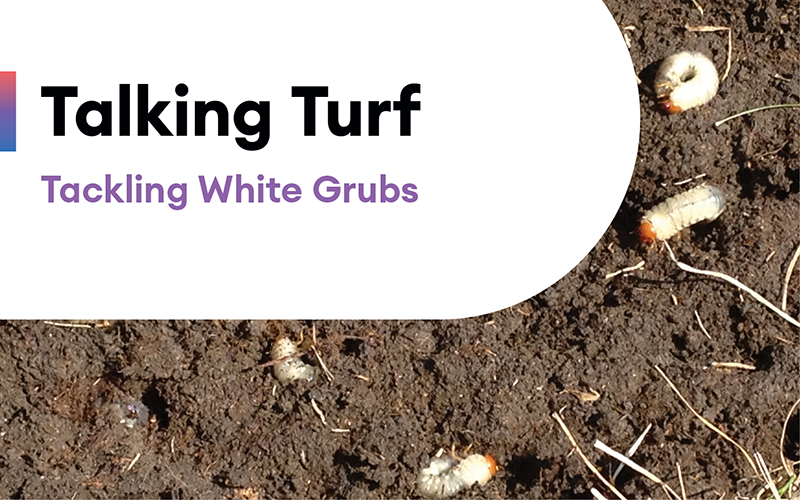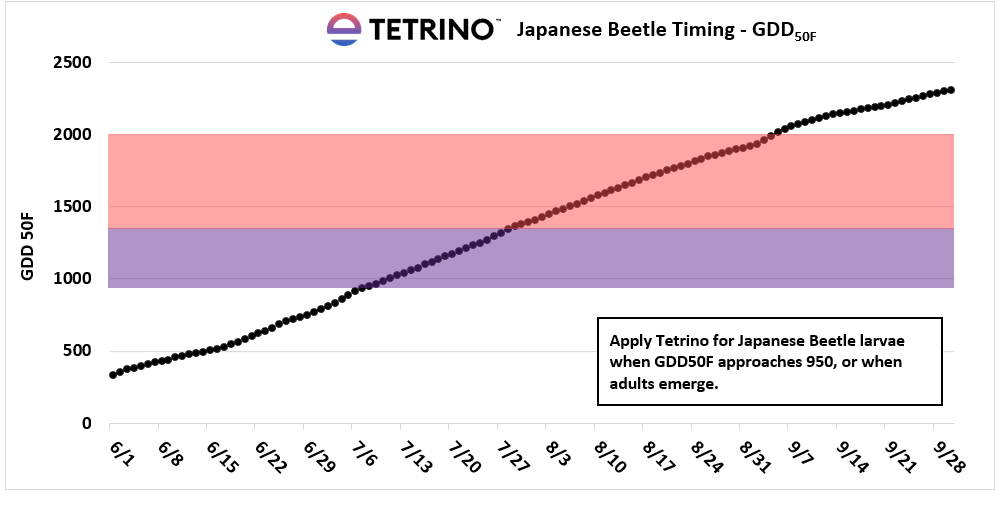Combating white grubs on time with our “apply when they fly” strategy
Scarab beetle larvae, typically called “white grubs,” form a group of destructive pests in turfgrass worldwide. Damage from white grubs can be devastating to turf in two ways: directly from larvae eating away at the root systems of your grass and indirectly from the physical damage from foraging animals. Planning your grub management now will go a long way to reduce potential losses throughout the summer and fall seasons.

Grub damage goes deep.
Turf damage occurs when larvae of a variety of scarab beetles, including northern and southern masked chafers, Asiatic garden beetles, European chafers, May or June beetles, Japanese beetles, green June beetles, and oriental beetles feed on the roots of turfgrasses causing severe damage.
Infested areas first turn yellow, then brown, before finally dying, no matter how much water the area receives. When the infestation is heavy, you may even be able to lift areas of turf from the soil because of a severed root system.
What’s worse is the havoc caused by moles, raccoons, skunks, birds and other animals that love to feed on white grubs as they dig and forage through infested turf in search of an easy meal.
Crafting your plan of action.
When using Tetrino® insecticide versus other products, you want to start applications for grubs when you first see adult beetles in flight, roughly late June to mid-August, depending on your location. Our TurfView model uses the latest scientific data combined with your personalized weather forecast to help you determine your best application timing to interrupt the life cycle right as adults emerge.
Late summer and fall bring out animals in search of grubs too, making late-season applications also important to reduce the risk of major damage from digging animals.

Envu solutions.
Integrated management programs that include the strategic use of insecticides should be utilized to control these damaging root feeders. Tetrino is a broad-spectrum, fast-acting insecticide that is effective against problematic white grubs. Insecticide performance can be affected by a few factors, including application timing and accuracy, amount of thatch, rainfall and/or irrigation following treatment, insect species, and insect infestation level and dosage. All these factors must be considered when treating with Tetrino insecticide to ensure that optimal insect control is achieved.
For season-long white grub control, apply Tetrino preventatively during peak adult flight, typically between late June to mid-August, depending on your location. Early curative treatments are very effective against second and third instar larvae when applied in August. Optimum control is achieved when applications are made prior to egg hatch of the target pests and when irrigation or rainfall occurs within 24 hours after application to move the active ingredient through the thatch into the soil profile. Tetrino fits any program either as a single preventative application or as a split application for a preventative and early curative strategy. Try our TurfView model for your location for optimal application timing.
For more information, download the white grub solution sheet or contact your local Territory Sales Manager for strategies specific to your needs.
ALWAYS READ AND FOLLOW PESTICIDE LABEL DIRECTIONS.
Envu, the Envu logo and Tetrino® are trademarks owned by Environmental Science U.S. LLC or one of its affiliates.
©2024 Environmental Science U.S. LLC. All rights reserved.
